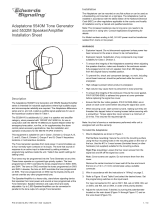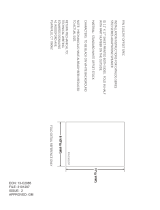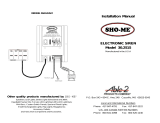Page is loading ...

P/N 3100009 ISSUE 2 © 2003
Installation Instructions for Catalog Series 5536M-24 and
5536MHV-24 Adaptatone
®
Millennium Local/System Signal
Description and OperationDescription and Operation
Description and OperationDescription and Operation
Description and Operation
Edwards Adaptatone is a heavy-duty, tone-selectable, stand
alone, indoor/outdoor audible signaling device intended
for industrial applications where high audible output and
microcomputer reliability are required. Catalog Numbers
ending with suffixes -24AQ or -24Y6 are CE Marked and
TUV-RHEINLAND Certified for compliance to the European
Union's Electromagnetic Compatibility (Industrial) and Low
Voltage Safety Directives (see Declaration of Conformtiy,
available upon request). Additionally, the Adaptatone
Millennium series are UL and cUL Listed as Audible Signal
Appliances for use in the following hazardous locations.
InstallationInstallation
InstallationInstallation
Installation
The Adaptatone may be mounted to any flat surface or
may be used as a freestanding unit mounted to a rigid
pipe. The Adaptatone must be installed in accordance
with the latest edition of the National Electrical Code or
other regulations applicable to the country and locality
of installation and by a trained and qualified electrician.
NOTE: The increased resistance due to long wire runs
needs to be accounted for in sizing wire.
Consult Applications Engineering for details.
For catalog numbers ending in "AQ", 24V AC power must
be transformer isolated from mains or line power.
1. Mount Adaptatone as shown in Figure 2.
a. Flat Surface Mounting. Secure unit to
mounting surface using the (4) mounting holes in
the mounting plate on the rear of the box. Use
the #10 x 3" (76 mm) wood screws (furnished loose)
or other hardware (not supplied) suitable for the
mounting surface.
b. Rigid Pipe Mounting. Loosen the (4) cover screws
from the signal box and lift off signal box cover.
NOTE: Cover screws are captive. Do not remove from
cover.
Remove the center knockout in lower wall of box
and mount box to a 1/2" (12.7 mm) conduit pipe
using suitable connector.
Dimensions
5536M 5536MHV
A 8 7/8" 11 1/2"
(225 mm) (292 mm)
B 8 1/4" 9 3/4"
(210 mm) (248 mm)
C 13" 16 1/2"
(330 mm) (419 mm)
Figure 1. Dimensions
Input Board Main Power
Catalog Current (A)
Number Voltage Current Voltage Standby Tone On
Standard Volume
5536M-24AQ 24V DC 6 mA 24V DC 0.10 0.74
24V AC 50/60 Hz 0.10 1.3
5536M-24N5 24V DC 6 mA 120V AC 50/60 Hz 0.10 0.36
5536M-24Y6 24V DC 6 mA 125V DC* 0.10 0.21
250V DC* 0.02 0.10
120V AC 50/60 Hz 0.10 0.32
240V AC 50/60 Hz 0.10 0.20
High Volume
5536MHV-24AQ 24V DC 6 mA 24V DC 0.10 1.5
24V AC 50/60 Hz 0.10 2.3
5536MHV-24Y6 24V DC 6 mA 125V DC* 0.10 0.39
250V DC* 0.02 0.19
120V AC 50/60 Hz 0.10 0.56
240V AC 50/60 Hz 0.10 0.34
*CE mark and TÜV-Rheinland Certifications do not apply to 125V DC or 250V DC.
CHESHIRE, CT 203-699-3300 FAX 203-699-3365 (CUST. SERV.) 203-699-3078 (TECH SERV.)
Catalog Hazardous Temp.
Number Locations Code
5536M-24AQ Class I, Div. 2, Groups A, B, C, D T4 (135C)
5536M-24N5 Class II, Div. 2, Groups F, G T5 (100C)
5536M-24Y6 Class III, Div. 1 and 2
5536MHV-24AQ
5536MHV-24Y6
The Adaptatone operates from local power and sounds a
high decibel signal determined by the setting of minia-
ture programming switches inside the unit. The
Adaptatone may be programmed for any of the 27 tones
listed in Figure 11.
Three tones may be programmed into the unit at any time.
These tones operate on a pyramid-type priority system.
The tone programmed on SW2 overrides the tones pro-
grammed on SW3 and SW4. The tone on SW3 overrides
the tone programmed on SW4. An external audio signal
up to 12V RMS can be connected to take priority over all
internally generated tone signals.
The decibel output level and speaker lateral position are
both easily adjustable.
Mechanical SpecificationsMechanical Specifications
Mechanical SpecificationsMechanical Specifications
Mechanical Specifications
Weight ...................................................9 Pounds (4.1 kg)
Hazardous Locations, UL Standard UL1604
Ambient Temp. ................... +41F to +104F (+5C to +40C)
Non-Hazardous Locations
Variable Ambient Temp. .....-40F to +151F (-40C to +66C)
Hazardous Locations and Variable Ambient Conditions apply only
where UL listings are accepted and do not apply to CE conformity or
TUV-Rheinland Certification.
Electrical SpecificationsElectrical Specifications
Electrical SpecificationsElectrical Specifications
Electrical Specifications
WARNINGWARNING
WARNINGWARNING
WARNING
To prevent fire, shock and component damage, NO work,
including circuit board removal, should be performed while
the circuit is energized.
NOTE: Any kind of service or maintenance performed
while unit is energized will void the warranty.

P/N 3100009 ISSUE 2
Speaker
Large star nut to
adjust speaker
direction
Signal Box
(4) Cover
screws
(4) Collar
gaskets
Raceway and connections
(not supplied) to
1/2" (12.7 mm) knockout
hole
(4) #10 x 3" (76 mm)
s
crews or other hardware
s
uitable for the mounting surface
2. Install wires through a knockout hole in the bottom
of the box from a raceway that is, with its connections
to the 1/2" (12.7 mm) conduit knockout hole, approved
for the same degree of protection and enclosure type
needed by the application. Use the provided plastic
tie-wrap, on the barrier to the electronics, to separate
incoming power leads from signal and tone initiating
leads, per NEC (Figure 3).
5. Adjust volume level, if desired, by turning
potentiometer located on the main board (Figure 9).
Figure 2. Adaptatone Mounting
3. Wire as follows:
a. Connect green and yellow striped earth-ground
wire to earth-ground.
b. Select the appropriate method for wiring to the
input board (Figure 9) from Figures 5 - 10. Connect
the Adaptatone as shown.
c. Connect incoming power to wire leads using a
butt splice or other method listed, certified, or
otherwise approved by local authorities. Leads
are both black for -AQ and -N5 models and are
black for line and white for neutral for -Y6 models.
d. Optional. Connect external 24V DC battery (not
supplied) in series with separate diode assembly
part 2600010 (supplied) to TB1 terminals 3 and 4
on the main board as shown in Figure 4 and
marked on the diode assembly.
NOTE: Terminal Block TB1 can be unplugged from the
main board to complete wiring as shown in
Figure 4.
WARNINGWARNING
WARNINGWARNING
WARNING
To prevent fire and shock, wire the Adaptatone only as
described in this installation instruction.
4. Refer to Figures 9 and 11 and select desired tones. Set
the miniature programming switches on the input
board.
For input connected to IN2, set on SW2; IN3, set on
SW3; IN4, set on SW4, in order of priority desired.
NOTE: Connection to IN1 is factory wired from Audio
Input Board for the external audio signal and
has priority over other signals when activated by
the 24V DC priority signal (Figures 7 and 8).
6. To adjust speaker direction, loosen large star nut
(Figure 2) and turn speaker to the approximate desired
position. Retighten nut and turn speaker slightly
clockwise until locked into place.
7. Tightly secure the signal box cover using (4) retained
cover screws.
8. Torque signal box cover screws to a minimum of 20
in-lbs.
9. Verify operability.
Table 1. Programming Logic Controller (PLC) Compatibility: PLC output to meet following product input
parameters. See Figure 10.
Operating voltage Max. off state Continuous on current Surge (inrush/duration)
Cat. No. (Volts*) leakage current (mA) (mA) (Amps/milliseconds)
5536M-24AQ 24V DC only 2 740 8/4
5536M-24N5 120V 60 Hz 2 360 2.82/4
5536MHV-24AQ 24V DC only 2 1500 8/4
Input Board Circuit 24V DC 2 6 --
WARNINGWARNING
WARNINGWARNING
WARNING
HIGH VOLTAGE is present when product is energized. High
volume may cause harm to personnel in close proximity.
WARNINGWARNING
WARNINGWARNING
WARNING
To ensure integrity of the enclosure: Ensure the cover
gasket, part number P-007549-0069, is adhered into
groove at cover perimeter before replacing the signal box
cover.
Ensure that the (4) collar gaskets, part number P-041930-
0362, are in place on each cover screw before securing the
signal box cover.
When securing cover, start screws by hand, making sure
they are threaded into tapped holes in housing bosses
before securing with a screwdriver. Torque signal box cover
screws to a minimum of 20 in-lbs. This ensures the
required tight fit.
WARNINGWARNING
WARNINGWARNING
WARNING
To ensure integrity of the Adaptatone assembly when
adjusting the speaker direction, make sure threads in the
enclosure remain fully engaged and do not turn speaker
more than 360 degrees from the original factory installed
position.
Page 2

P/N 3100009 ISSUE 2
(-)
(+)
W
iring is factory
installed to internal
power supply
(-)
(+)
(-)
(+)
To optional 24V D
C
Battery Backup
24
13
Diode Assembly
2600010
2
4
1
3
Terminal Block
TB-1
Main
Board
Plastic tie-wrap (provided)--
use to separate power leads
from signal and tone initiating leads
Power and
earth-ground
leads--black and
white or black for
power; yellow
striped green for
earth-ground.
Signal/Tone leads from 5540 to be
connected to Audio Coupler Board as
applicable.
Figure 4. Wiring to Terminal Block TB1
Figure 3. Wiring the Adaptatone
Maintenance and Maintenance and
Maintenance and Maintenance and
Maintenance and
TT
TT
T
estest
estest
est
Examine the unit semi-annually for accumulation of dirt.
Clean if necessary.
The Adaptatone should be tested annually or as required
by the authority having jurisdiction to ensure continuous
service.
Page 3
WARNINGWARNING
WARNINGWARNING
WARNING
To prevent fire, shock and component damage, NO work,
including circuit board removal, should be performed while
the circuit is energized.
NOTE: Any kind of service or maintenance performed
while unit is energized will void the warranty.

P/N 3100009 ISSUE 2
INPUT BOARD
PROCESSOR BOARD
MAIN BOARD
POTENTIOMETER FOR
VOLUME ADJUSTMENT
IN4
N
+VS
GND
PROGRAMMING
SWITCHES
(ON OTHER SIDE)
IN1
IN2
IN3
AUDIO INPUT BOARD
S
W
1
S
W
2
S
W
3
S
W
4
SYSTEM
CONSOLE
AUDIO (+)
RELAY
POWER SUPERVISION
(WHERE APPLICABLE)
AUDIO
+
AUDIO
-
AUDIO COUPLER BOARD
TO OTHER UNITS'
AUDIO COUPLER BOARDS
AUDIO (-)
NOTE: Audio Signal
not to exceed 10Vrms
IN1 IN2 IN3 IN4 N +VS GND
(5V DC to 24V DC +/- 1%)
FROM CUSTOMER
CIRCUIT
CUSTOMER CIRCUIT
ON INPUT
BOARD
IN1 IN2 IN3 IN4 N +VS GND
K3
K2
K1
24V DC
Priority Signal
T
o Command
Line
K1 - K3
Local Priorities
O
n Input Board
IN1 IN2 IN3 IN4 N +VS GND
K3
K2
K1
On Input Board
Priority
Signal
Activation
Figure 9. PC Board Locations
Figure 8. Connecting Audio Signal, not to exceed
10Vrms, from Tone Generator to
5536M Audio Input Board
Figure 6. Connecting 24V DC Priority Signal to the
Input Board for Activation of External Audio Signal
Connected to Audio Input Board (Figure 8)
Figure 5. Installing with Multiple Dry Relay Contacts
Internally Generated Tones Only
Page 4
Figure 7. Installing with an open collector transistor for
24V DC tone initiation to IN1, IN2, IN3 or IN4

P/N 3100009 ISSUE 2
IN1 IN2 IN3 IN4 N +VS GND
VDC 1
OUT 0
OUT 1
OUT 2
OUT 3
OUT 1
OUT 2
OUT 3
OUT 4
OUT 5
OUT 6
OUT 7
DC COM
+24V DC (EXTERNAL POWER SOURCE)
Input Board
PLC
SEE NOTE
NOTE: IN1 can be connected to a 24V DC priority signal for activation of external
audio signal connected to Audio Input Board.
Figure 10. Connecting 24V Input Board to a PLC. See Table 1.
Figure 11. Tone Programming
Switch
Tone Description 12345HEX
No Tone 00
Ding-Dong Percussive pairs of 700 and 570 Hz tones, each damped to zero 01
Warble 575 and 770 Hz alternately, 87 ms each 02
Siren 600-1250 Hz up and down sweep in 8 seconds and repeat 03
Stutter Percussive 470 Hz, 83 ms on, 109 ms off 04
Slow Whoop 600-1250 Hz upward sweep in 4 seconds and repeat 05
Beep 470 Hz, 0.55 seconds on, 0.55 seconds off 06
Chime 1 700 Hz percussive repeat at 1 Hz 07
Fast Whoop 600-1250 Hz upward sweep in 1 second and repeat 08
Hi/Lo 780 to 600 Hz alternately, 0.52 seconds each 09
Rapid Siren 600-1250 Hz up and down sweep in 0.25 seconds and repeat 0A
Yeow 1250-600 Hz downward sweep in 1.6 seconds and repeat 0B
Horn 470 Hz continuous 0C
Air Horn 370 Hz continuous 0D
Dual Tone 450-500 Hz, 0.4 to 0.5 second cycle 0E
Chime 2 575 Hz percussive repeat at 1 Hz 0F
Westminster Two measures, 411 Hz, 520 Hz, 407 Hz, 312 Hz 10
Three Blind Mice Four Measures, 787 Hz, 714 Hz, 625 Hz, 952 Hz, 333 Hz 11
Phasor 416-625 Hz up and down sweep in 13 ms and repeat 12
Telephone 570 and 770 Hz alternately, 50 ms each for 1.2s, 1.5s delay and repeat 13
Staircase 440-2000 Hz up and down steps, 750 ms delay and repeat 14
3 Tone Alert 463, 641 and 896 Hz, 200 ms each, 1 second delay and repeat 15
Presignal Chime 470 Hz percussive repeat at 1.5 Hz, followed by Message 1 16
NFPA Whoop 422-775 Hz, upward sweeps, 850 ms each, 1 second delay and repeat 1B
3 Pulse Horn 470 Hz, 3 0.5 second pulses separated by 0.5 seconds followed 1C
by a 1.5 second delay and repeat--For Evacuation Use Only
3 Pulse Air Horn 370 Hz, 3 0.5 second pulses separated by 0.5 seconds followed 1D
by a 1.5 second delay and repeat--For Evacuation Use Only
3 Pulse Dual Tone 450-500 Hz, 0.4 to 0.5 second cycle, 3 0.5 second pulses separated 1E
by 0.5 seconds followed by a 1.5 second delay and repeat--For
Evacuation Use Only
3 Pulse Chime 2 575 Hz, 3 0.5 second pulses separated by 0.5 seconds followed 1F
by a 1.5 second delay and repeat--For Evacuation Use Only
CAUTIONCAUTION
CAUTIONCAUTION
CAUTION
The use of evacuation signals on this product, that is not specifically Listed for
Fire Alarm Use, is subject to the approval of the Authority Having Jurisdiction.
Page 5
/








